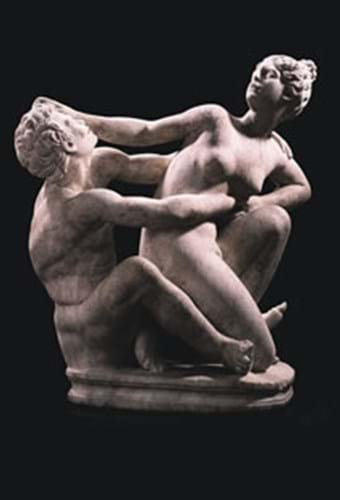
Depicting a nymph struggling to resist the predatory advances of a satyr, the piece is of almost square format, measuring 2ft 4in (71cm) high including the round integral base, 2ft 21/2in (66cm) wide and 211/2in (54.5cm) deep. The sculpture itself is Roman, dating from c.1st-2nd century AD, but the heads are Italian Renaissance replacements. The work was aquired some time before 1905 from the Florentine art connoisseur, antiquarian and dealer Stefano Bardini by financier William Waldorf Astor for his newly acquired home, Hever Castle in Kent, and was used as part of the Italian sculpture garden in the grounds. When the Astor family sold Hever and its contents in 1983 the statue was purchased by the new owners Hever Castle Ltd and it was subsequently acquired by Bonhams' vendor.
The marble had accordingly spent almost a century in a garden setting and was covered in grime and lichen. Bonhams had the work cleaned at the Conservation Department of the National Museum and Galleries on Merseyside to reveal a dynamic group of appealing size which Bonhams put on display as the centrepiece of their sale viewing in the reception area at New Bond Street.
A Symplegma (or closely knit group of two people) is a specific type of classical sulpture that, unlike single figures, seldom comes up for sale. The best known relative to Bonhams' sculpture is the nymph and satyr in the British Musuem that comes from the collection of Charles Townley.
With little recent saleroom precedent, the auctioneers were not sure quite how much the piece would fetch and had hopes that it could make anything up to £1m. Evidently there was much more flexibility when it came to the auction with chairman Robert Brooks, who took the sale, pointing out to a packed but seemingly hestitant room that the piece was "here to be sold".
In the event, the only obvious interest from the room came from the successful purchaser, a private collector with a growing antiquities collection who secured it for £380,000. Asked after the sale why the piece hadn't generated more interest, Bonhams' Joanna Van der Lande felt that the explicit nature of the subject matter and the lack of American interest, given the dollar's weakness were the main factors. There could, however, also be the possibility that as a classical piece with Renaissance heads, the work falls between two stools of taste and collecting.
Anne Crane




